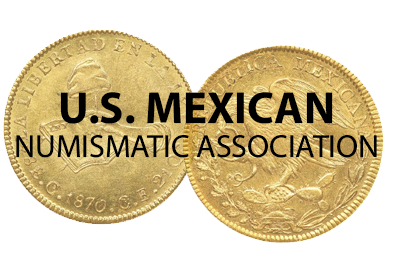The Ibero-American Series
In 1991, the Spanish-speaking countries of Latin America, together with Spain and Portugal, began an unprecedented project. The Ibero-American Series are coins and medals that are issued over a certain period of time, which have on their reverse the main theme of each series and on the obverse they display in the centre the coat of arms of the issuing nation surrounded by the coats of arms of the countries that make up that series.
Each series was issued over a period of approximately three years, in a joint effort of the Ibero-American countries to show the most important and outstanding features of their territory.
Each Ibero-American series has a name. Not all countries participate in all the series but in the case of Mexico, it took part in nine of the ten series.
The series that have taken place so far have the following themes:
1991 – Series I: Fifth Centenary of the Discovery of America
1996 – Series II: Endangered native animal species
1998 – Series III: Typical Ibero-American Dances and Costumes
2000 – Series IV: Man and the Horse
2002 – Series V: The Nautical tradition
2005 – Series VI: Architecture and Monuments
2008 – Series VII: Ibero-American Countries in Olympic Sports
2010 – Series VIII: Historical Ibero-American Coins
2013 – Series IX: 20th Anniversary
2015 – Series X: Cultural Roots.
All the coins minted by Mexico are in 0.925 sterling silver, weigh 27 grams and have a diameter of 40 mm.
Quincentennial of the Discovery of the Americas
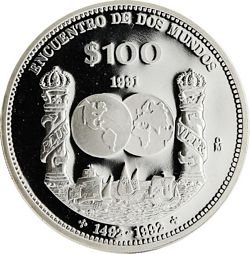
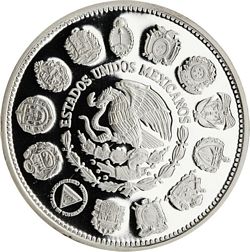
KM-540 $100
Mexico's contribution to the first series was the historic Columnnaria (Pillars) design with globes of the Western and Eastern hemispheres between the Pillars of Hercules and the ships of Christopher Columbus below. This is the only coin in the series denominated 100 pesos: later Ibero-American coins are denominated 5 pesos.
The mintage was 30,000 for 1991, and 20,000 in 1992.
Endangered native animal species
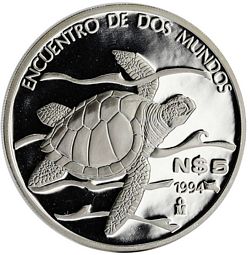
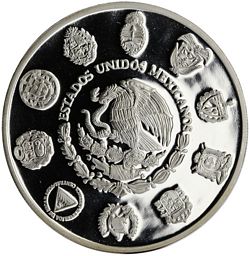
KM-588 N$5
Mexico's contribution to the second series with the denomination N$5 to accommodate the Coinage Reform of 1992, depicts the olive ridley sea turtle (Lepidochelys olivacea) known in Mexico as the golfina turtle, on the reverse.
The mintage was 11,005 in 1994.
Ibero-American Dances and Costumes
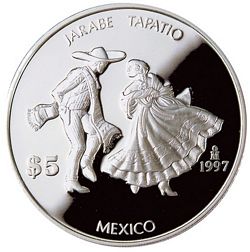
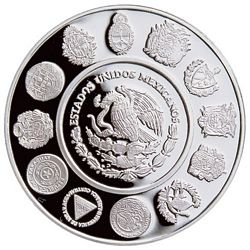
KM-629
Mexico's contribution to the third series, which commenced in 1996, depicts the Jarabe Tapatío, a traditional Mexican dance that dates from the 15th century in Spain. The Jarabe Tapatío (Mexican Hat Dance) represents the courtship of a man and woman, with a woman rejecting and then accepting the man's advances. The woman wears a colourful dress costume called the china poblana, while the men wears a heavily decorated charro outfit.
Mintage was 8,011 in 1997 and 3,000 in 1998.
Man and the Horse
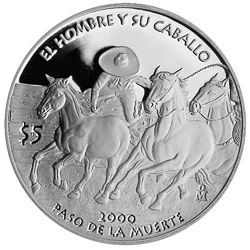
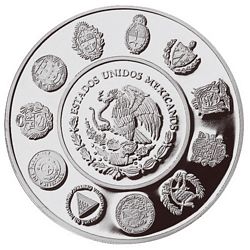
KM-670
For the fourth series, Mexico contribution, dated 2000 but released in 2001, depicts the Paso de la Muerte, or “Ride of Death”. The Spanish brought horses to Mexico, along with an event called the charreada – a kind of rough, competitive rodeo. In the Paso de ;a Muerte, a charro (cowboy) attempts to leap from his galloping horse to the back of an unbroken horse with no saddle or bridle. The goal is to remain on the wild horse until it stops bucking, and if this is not possible, to avoid falling under the other galloping horses and their charros.
Mintage was 9,000 in 2000.
The Nautical tradition


KM-678
In the fifth series, the central figure of Mexico's coins, the Galeón de Acapulco, commemorates the galleons that made trade possible between the Far East and Mexico during the Hernán Cortes era of the early 1500s. The galleons bought silks and spices from China and works of art from Japan. Returning to Manila, in the Philippines, the ships took millions of pesos in silver to pay for the Asian goods. The final Galeón de Acapulco voyage took place in 1815, during Mexico's struggle for independence from Spain.
Mintage was 17,105 in 2003.
Architecture and Monuments
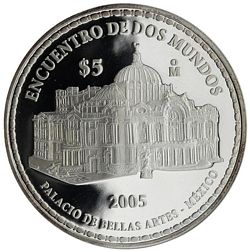
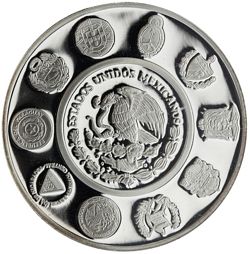
KM-765
The reverse of Mexico's contribution to the sixth series features the Palacio de Bellas Artes (Palace of Fine Arts), which is located next to the Alameda Central Park in Mexico City. It is home to Mexico's national theatre, ballet and symphony orchestra. President Porfirio Díaz commissioned the palace to replace the old national theatre building. Italian architect Adamo Boari was awarded the project, which was delayed by political strife and construction problems. Finally completed in 1934, the palace blends Art Nouveau, Art Deco and Baroque architectural styles.
Mintage was 8,005 in 2005.
Ibero-American Countries in Olympic Sports
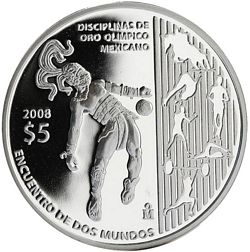
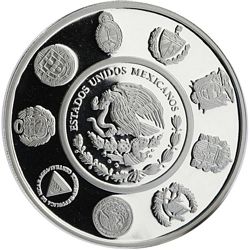
KM-805
This coin celebrates Disciplinas de Oro Olimpíco (Mexican Gold-Medal Disciplines). At the left is a Mayan ball player in the game of pelota: on the panel at the right symbols depict the six Olympic sports in which Mexican participants have won gold medals.
Mintage was 8,013 in 2008.
Historical Ibero-American Coins
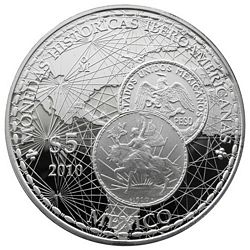
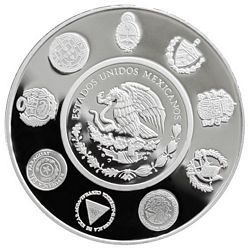
KM-962
In the eighth series Mexico's coin (dated 2010 and released in 2011) carries the series name, “Monedas Historícas Iberoamericanas”. In the background is a portion of a 1562 map, the “Carta Marina Nuova Tavola”, by Girolamo Ruscelli: it depicts one of the earliest cartographic depictions of California's peninsula (just visible above the denomination on the coin). Superimposed over the map is Mexico's chosen historical coin, the one peso of 1910 known as the “Caballito”. It was designed by French engraver Charles Pillet and commemorated the 100th anniversary of the start of the War of Independence.
Mintage was 8,000 in 2010.
For the ninth and final issue the countries that participated most throughout the series produced 40 mm commemorative medals (Mexico's mintage was 2000). The reverse of Mexico's contribution displays miniature versions of each of the eight Iberoamericana issues, along with the fleet of Columbus between the outlined continents of Europe and North and South America. The legend at the centre reads ENCUENTRO DE DOS MUNDOS 2012.
(information from Don and Lois Bailey, Whitman Encyclopedia of Mexican Money, Volume 2 Modern Coins of Mexico, 1905 to Date)
